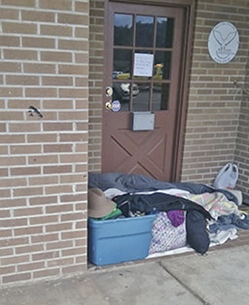
“I’ve been homeless off and on for five years, but it’s not like I sleep on the street.”
Speaking on the condition of anonymity, the twenty-something woman walking the streets of Andrews has experienced homelessness in Cherokee, Graham and Swain counties.
However, she insists “it’s not like I sleep on the street. I mostly couch-surf, or when I had a tent, I’d camp. When I had a car, I’d sleep in the backseat. I’ve even slept in barns and sheds and abandoned buildings. Nobody wants to sleep outside all exposed to whatever might come along.”
This makes the young woman one of the “hidden homeless,” those with no permanent residence but who are missed in the Department of Housing and Urban Development’s “point-in-time” count.
The count happens on a specific night in January and the results affect allocation of services in two ways. People who fail to meet the HUD definition of homelessness – because they are neither on the streets or in a shelter – are not eligible for emergency-shelter grants.
Communities also lose federal funding when the homeless population is undercounted. The Department of Education estimates that the number of rural homeless is at least 11 percent higher than HUD’s PIT data reflects.
In rural areas where most homeless people are doubling up with other families, sleeping in cars, camping, or sleeping on couches, making an accurate count is even more of a challenge than in urban areas.
Pastor Eric Reece of Robbinsville United Methodist Church has participated in the PIT count and refers to the process as “almost impossible. Finding homeless people on a cold night in January, then getting them to answer a 20-question survey? It’s very, very difficult.”
Even if they do reflect an undercount, the HUD numbers are sobering. On any given day in
2018, 9,268 people experienced homelessness in North Carolina, while 26,361 students experienced homelessness during the 2016-17 school year.
Without accurate PIT counts and the federal dollars that follow such numbers, both the rural homeless and rural communities can be left to deal with the issue of homelessness largely on their own.
Regarding homeless shelters in Graham County, Mike Teem of Celebrate Recovery said, “There aren’t any. Highways N Hedges in Cherokee County has a shelter, but as far as in Graham County, no. We are trying to work on it, but right now all we can do is help people get to Highways N Hedges.”
Kristie Sluder works with Grace Extended Ministries to provide support services to struggling residents, including some who are homeless. She considers areas like Graham County to be “a perfect storm” for homelessness.
“Mental health problems, addiction, lack of available housing, poverty, lack of a living wage: we have to address all of these issues,” Sluder said.
According to a study by HUD, 45 percent of homeless people have a history of mental illness. The National Coalition for the Homeless calculated that 64 percent of the homeless suffer from addiction to alcohol or drugs. Many people who find themselves homeless have a dual diagnosis, with mental illness triggering addictive behavior, often as an attempt to self-medicate.
Census numbers show that Graham County has an appropriate housing stock for its population size. However, Sluder pointed out that, “those numbers don’t take into account the number of houses used as short-term rentals. That really cuts into the available rental pool, which was not large to begin with.”
As the poorest county in North Carolina and the only one designated as “distressed” by the Appalachian Regional Commission, Graham County is a place where many residents struggle to meet basic needs. With U.S. Census numbers showing 18.1 percent of Graham County residents living below the poverty line, nearly 1-in-5 people in the county is not financially equipped to deal with triggering events such as addiction, illness, or loss of employment.
As Pastor Reece said, “We’re all just one paycheck away from having to make some difficult choices.”
One example is the homeless woman who asked that we not use her name.
“I became homeless when my boyfriend tried to kill me for the second time,” she explained. “I knew I had to leave, but I had nowhere to go. I couldn’t go to my mom’s house. She’s got problems of her own, mostly meth, which is really the only problem you need.
“The guy I left, we had the same circle of friends, so I couldn’t go to any of them. Even my boss was a friend of his, so when I walked out that door, I lost my job, my apartment, and every friend I had.
“When I’ve applied for jobs, people saw my teeth, and I knew what they were thinking: druggie. Trash. Druggie trash. I’m not saying I’ve never done drugs, but my baby teeth didn’t fall out: they rotted out. By the time I could take own self to the dentist, there was nothing left to do but pull most of them. I’m not even thirty and I look like this. And who’s gonna hire somebody with teeth like this?
“I’ve gotten job interviews, but it’s so hard to look presentable. I try, but there are hardly any jobs around here and if I got one, the truth is, that’s not going to suddenly make me not homeless. How long would it take to save up enough for first-month’s and last-month’s rent and a deposit? $1,500? It’s demoralizing. It’s depressing. I just can’t see a way out.”
“Winding up homeless is like falling out of a boat. It’s easy to fall, but it’s almost impossible to climb back on-board.
“Nobody would want to live like this. Absolutely nobody.”
Grace Extended Ministries may be reached at 735-1351, while Highways N Hedges can be found on Facebook.
